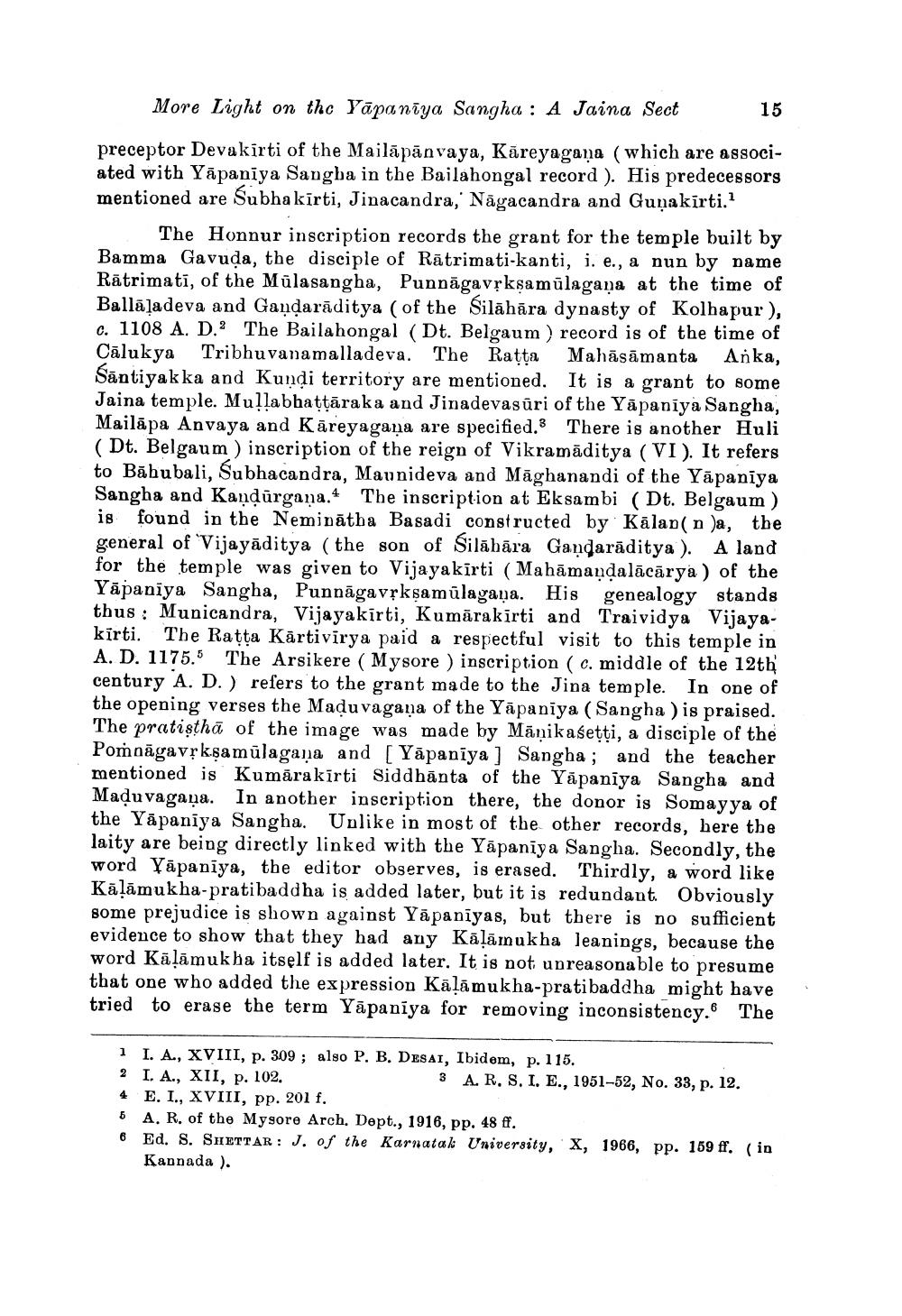Book Title: More Light On Yapaniya Sangha Author(s): A N Upadhye Publisher: A N Upadhye View full book textPage 8
________________ More Light on the Yapaniya Sangha: A Jaina Sect preceptor Devakirti of the Mailapanvaya, Kāreyagana (which are associated with Yapaniya Sangha in the Bailahongal record). His predecessors mentioned are Subha kirti, Jina candra, Nagacandra and Gunakirti.1 The Honnur inscription records the grant for the temple built by Bamma Gavuda, the disciple of Ratrimati-kanti, i. e., a nun by name Rātrimati, of the Mulasangha, Punnagavṛkşamülagana at the time of Ballaladeva and Gandaraditya (of the Silahara dynasty of Kolhapur), c. 1108 A. D. The Bailahongal (Dt. Belgaum) record is of the time of Calukya Tribhuvanamalladeva. The Ratta Mahasamanta Anka, Santiyakka and Kundi territory are mentioned. It is a grant to some Jaina temple. Mullabhaṭṭāraka and Jinadevasüri of the Yapaniya Sangha, Mailapa Anvaya and Kareyagana are specified. There is another Huli (Dt. Belgaum) inscription of the reign of Vikramaditya (VI). It refers to Bahubali, Subha candra, Maunideva and Maghanandi of the Yapaniya Sangha and Kandūrgana. The inscription at Eksambi (Dt. Belgaum) is found in the Neminatha Basadi constructed by Kalan(n)a, the general of Vijayaditya (the son of Silahara Gandaraditya). A land for the temple was given to Vijayakirti (Mahamaṇḍalācārya) of the Yapaniya Sangha, Punnagavṛkṣamulagana. His genealogy stands thus Municandra, Vijayakirti, Kumarakirti and Traividya Vijayakirti. The Raṭṭa Kartivirya paid a respectful visit to this temple in A. D. 1175.5 The Arsikere (Mysore) inscription (c. middle of the 12th century A. D. ) refers to the grant made to the Jina temple. In one of the opening verses the Maduvagana of the Yapaniya (Sangha ) is praised. The pratistha of the image was made by Manikasetti, a disciple of the Pomnagavṛkṣamulagana and [Yapaniya] Sangha; and the teacher mentioned is Kumārakirti Siddhanta of the Yapaniya Sangha and Maduvagana. In another inscription there, the donor is Somayya of the Yapaniya Sangha. Unlike in most of the other records, here the laity are being directly linked with the Yapaniya Sangha. Secondly, the word Yapaniya, the editor observes, is erased. Thirdly, a word like Kālāmukha-pratibaddha is added later, but it is redundant. Obviously some prejudice is shown against Yapaniyas, but there is no sufficient evidence to show that they had any Kālāmukha leanings, because the word Kalamukha itself is added later. It is not unreasonable to presume that one who added the expression Kalamukha-pratibaddha might have tried to erase the term Yapaniya for removing inconsistency. The 1 I. A., XVIII, p. 309; also P. B. DESAI, Ibidem, p. 115. 2 I. A., XII, p. 102. 15 3 A. R. S. I. E., 1951-52, No. 33, p. 12. 4 E. I., XVIII, pp. 201 f. 5 A. R. of the Mysore Arch. Dept., 1916, pp. 48 ff. 6 Ed. S. SHETTAR: J. of the Karnatak University, X, 1966, pp. 159 ff. (in Kannada ).Page Navigation
1 ... 6 7 8 9 10 11 12 13 14 15
